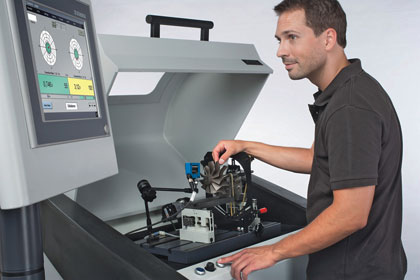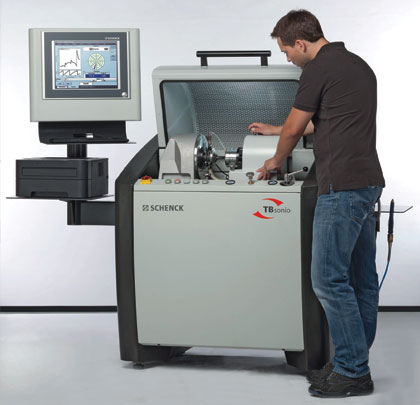For most people, turbochargers are associated with vehicles they see zooming past on the road with an extra boost of power. According to a 2012 article in USA Today, Honeywell Turbo Technologies said, “The little devices, which use otherwise wasted exhaust gases to help engines breath better, increasing performance, and fuel economy, will show up in an estimated 3.2 million new vehicles this year. That’s up from 2.2 million [in 2011].” In addition, with increasingly strict fuel consumption and emission regulations leading to the downsizing of engines, forecasts indicate that this number will double again by the year 2020. Those in the business of turbocharger overhaul can benefit from this rapidly growing market.
DURABLE, RELIABLE, AND ECONOMICAL
Performance, fuel efficiency, reliability, and noise reduction are just a few of the main design focuses for today’s turbocharger users. These points are not only a main focus for the original equipment manufacturer, but are also key points for the overhaul facility. In fact, with the wide range of part types moving through a typical overhaul facility, overhaul can often prove to be a significant challenge. To get the most performance and longest service life out of your remanufactured products, you need equipment that will provide a complete solution from the basic components to the complete assembly.
Although turbochargers are designed for a very long life cycle, wear and damage can still occur—most often due to improper maintenance. Balancing in conjunction with careful overhaul using quality components helps to ensure a smooth running, high quality, reliable turbocharger that is comparable to a new unit.
REPAIR VS. REPLACE
Defective turbochargers are often replaced with brand new units at considerable cost. However, with the right expertise and suitable equipment, turbochargers can be overhauled to like new condition at significantly reduced cost. Schenck has over thirty years of experience with balancing equipment designed specifically to meet the demanding requirements of the turbocharger production and overhaul markets. In focusing our expertise on turbocharger balancing during overhaul, Schenck developed their TBcomfort and TBsonio machines to provide users with the capability to balance the individual components as well as the complete core assembly.
TURBOCHARGER BALANCING
We are repeatedly asked why balancing is so important when repairing turbochargers. With typical operating speeds up to 250,000 revolutions per minute, the need for balancing is clear. With this in mind, Schenck Trebel Corporation offers its TB series of equipment designed to improve balancing quality, efficiency, and profitability in the overhaul of turbochargers. Complete balancing of a turbocharger during overhaul is a multi-step process.
First, the turbine wheel/shaft and compressor wheel must be balanced individually at low speed in order to reduce the initial unbalance. This low speed step is easily accomplished using the Schenck TBcomfort horizontal balancing machine. Without low speed balancing, accelerating the core during high speed balancing could lead to damage or possibly a core in which the high speed vibration limit tolerances simply cannot be achieved. Once the components are individually balanced, the next step is either low speed balancing of the rotating group (turbine wheel/shaft with compressor wheel installed) or high speed balancing of the completely assembled turbocharger core. The latter of which is performed on the Schenck TBsonio. The TBsonio is capable of running the assembled turbocharger at high speed in order to reduce the vibration levels throughout the entire operating range of the core assembly.
The TBcomfort and TBsonio are both constructed around a cast mineral concrete base. The machines are, therefore, less susceptible to external interference effects and do not require a foundation. This basic design also allows the machine to simply be picked up by forklift and re-positioned if needed. All that is required is electrical power and compressed air and the machines are ready for production.
LOW SPEED BALANCING
The Schenck TBcomfort has been developed to provide a complete solution from component balancing of the turbine wheel/shaft and compressor wheel to final trim balancing of the rotating group. From the one-handed operation of the overslung belt drive assembly to the electronic protractor feature, the TBcomfort machine is easy to use and convenient. Focused specifically on turbocharger components, the TBcomfort achieves an extremely high level of accuracy and repeatability by employing a custom turbocharger fixture for the smaller range of components. Housed within a class C type safety barrier, there is increased safety, reduced fatigue on operators, less noise in the shop area, fewer balancing runs per component and overall improved production throughput.
NO CALIBRATION RUNS REQUIRED
Constructed with a permanently calibrated design, calibration checks are not required with low-speed balancing on the TBcomfort machine. The setup of the machine requires only the input of the rotor’s geometric data on the measuring unit and the machine is ready for balancing. Additionally, the high measuring accuracy of the TBcomfort saves time and cost, since a single measuring run and correction step is usually enough to bring the rotor into tolerance.

The TBcomfort (seen here) provides users with reliable turbocharger balancing.
HIGH SPEED BALANCING
Turbocharger core assemblies are not a constant. The behavior of the core assembly changes throughout the operating range of the core. Therefore, analysis of the core assembly at a single point or peak is no longer adequate for today’s most demanding customers. In order to assemble a core that will provide the maximum performance under all operating conditions, complete analysis of the core throughout its operating range is essential. This is where the Schenck TBsonio steps in.
The Schenck TBsonio turbocharger core balancer is designed to balance assembled turbocharger cores at speeds of up to 250,000 rpm. The high-speed capability of the TBsonio allows for the measurement of the unbalance throughout the entire operating speed range of the turbocharger. Instead of displaying a digital snap shot of a single point, the unbalance is measured across the operating speed range. Taking this a step further, the TBsonio uses all of the unbalance data to optimize the unbalance correction for the entire operating range of the core assembly. After performing a balancing run, a single unbalance correction is displayed for quick and easy correction, thus reducing balancing time.
With the correction displayed in terms of mass (g., mg., oz.), and the standard electronic protractor feature guiding the operator to the proper angular location on the rotor for correction, there’s no guess work. Material removal is accurate and effective. The electronic protractor feature provides a dynamic real-time “radar sweep” display of the current angular location while the rotor is rotated by the operator. There’s no need to rely on estimates for the proper angular location, simply watch the visual display on the CAB950 as the rotor is rotated until the proper angle is reached.
To further ease the correction process, material removal can be performed directly in the TBsonio workstation with the optional pneumatic hand grinder. Transferring the assembly to a correction station is not necessary. Therefore, the core is loaded into the balancing machine once, loading and unloading for correction is not required. Thus, balancing time is greatly reduced.
The capabilities of the TBsonio not only help to improve balancing production, but its capabilities go beyond balancing. For further detailed analysis of a turbocharger core, a Bode or Nyquist diagram is displayed. In addition, the optional printer documentation system allows the operator to print unbalance reports, rotor setup data, and full page graphics.
CAB MEASURING UNITS
Both machines are equipped with proven CAB (computer aided balancing) measuring units. In the case of the TBcomfort, this is the new CAB 820 or CAB 920 SmartTouch. The TBsonio is only offered with the CAB 950 instrumentation with software developed specifically to target the high speed balancing of turbocharger core assemblies. All units employ Windows based software, offer high measuring accuracy, touch screen technology, and user friendly interfaces to streamline the setup and measurement processes.
With their sophisticated measuring concept, the TBcomfort and TBsonio machines can achieve measuring efficiency and accuracy levels that produce overhauled turbocharger assemblies comparable to new turbochargers. The benefits for turbocharger overhaul facilities are fast and accurate measurement and correction, ease of use, and increased production.
_______________________________________________________________________
ABOUT THE AUTHOR
David Fanning is a senior applications engineer (turbochargers) for Schenck Trebel Corporation. For more information, visit www.schenck-usa.com.
_______________________________________________________________________
MODERN PUMPING TODAY, November 2013
Did you enjoy this article?
Subscribe to the FREE Digital Edition of Modern Pumping Today Magazine!



